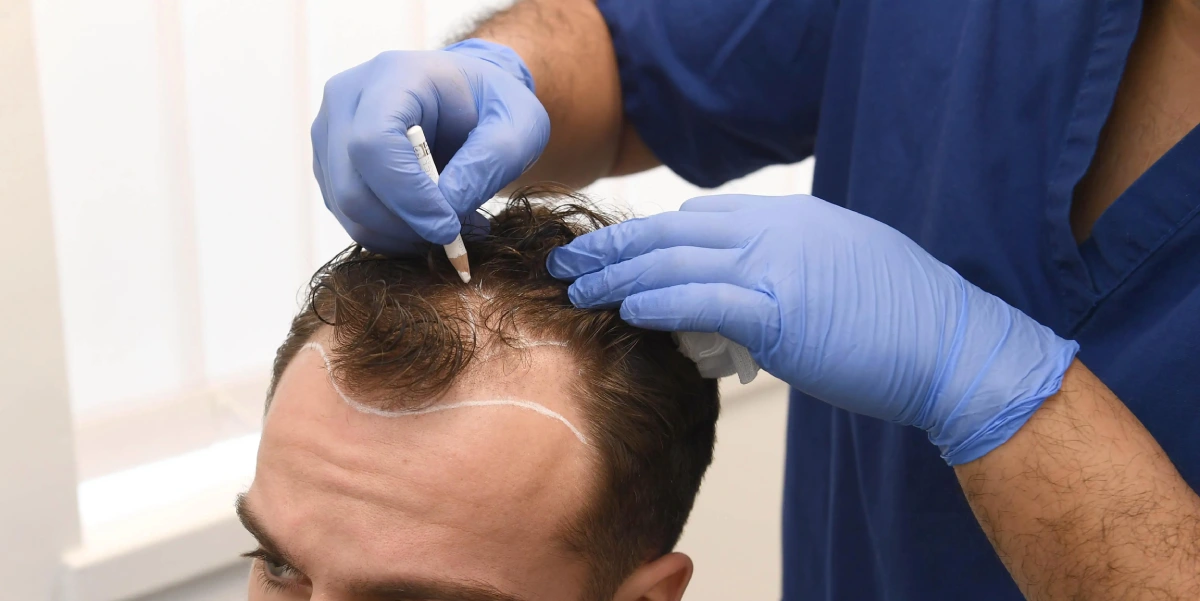Hair loss has been a concern for many in the past, but it is becoming more common nowadays. Hair thinning or loss is a serious issue, and we should treat it with the same seriousness as other minor issues. While many people have baldness or permanent hair loss issues that cannot be reversed, early hair thinning can be treated. In the contemporary scientific realm, addressing hair loss issues is a straightforward process. With an advanced hair transplant in Riyadh, Saudi Arabia, at Cosmetic Clinic Jeddah, you can get the desired hair transplant.
A hair transplant, or hair restoration, is a surgical procedure to restore hair volume in areas experiencing hair thinning or loss. Hair transplantation in Riyadh is considered the most natural technique for dealing with hair loss problems. The hair restoration technique is not only for scalp hair; it also helps with beards, eyebrows, mustaches, sideburns, and body hair transplants.
At Cosmetic Clinic Jeddah, our expert hair surgeons perform hair transplants using your own hair follicles. In Saudi Arabia, our expert hair surgeons extract hair follicles from the back of your scalp, known as the donor site, and then transplant them into areas experiencing hair thinning or hair loss. Male-pattern baldness and female-pattern hair loss are the most common problems.
A hair transplant in Jeddah, Riyadh, Saudi Arabia, is considered a safe and quick procedure without any risk. Expert surgeons perform the procedure, ensuring a 99% success rate. The main goal of hair transplant treatment in Riyadh is to address a wide range of hair loss concerns, including male pattern baldness, hair thinning, alopecia, female pattern hair loss, and receding hairline.
In Jeddah, hair transplantation can treat a variety of hair loss causes. Here are some of the primary causes of hair loss:
Aside from restoring a full head of hair, our Jeddah hair transplant offers a variety of benefits, including:
Riyadh and Saudi Arabia use various types of hair transplants, each with its own set of features and benefits, to treat hair loss. The specialist determines the most appropriate technique by examining the hair to assess the extent of hair loss and identify the donor area. Some of the popular techniques are:
The invasive procedure known as FUE hair transplant, or follicular unit extraction hair transplant, involves removing individual hair follicles from the donor site and transplanting them to the hair loss area. A physician employs a specialized extraction instrument to remove clusters of one to four hairs from the back of the head or the sides of the neck. The physician then transplants the follicles into a thinning area of the scalp, positioning them at an angle to blend in with the surrounding hair.
There are two types of FUE Hair Transplant:
The FUT hair transplant, also referred to as follicular unit transplantation (FUT) or the strip method, involves removing a strip of hair-bearing tissue from the back of the head and transplanting it into balding areas. After the procedure, we stitch or staple the strip, which typically measures 0.5–1.5 cm wide and 5–30 cm long.
DHI, a sharp implantation technique, is a modification of the Follicular Unit Extraction (FUE) method. People claim it to be a more direct and controlled approach compared to traditional methods such as follicular unit transplantation (FUT), which requires pre-made incisions.
Non-surgical treatments for hair loss include the following:
Platelet-rich plasma (PRP) therapy is an outpatient treatment that involves injecting a patient’s concentrated platelets into an injured area to promote healing. Centrifuging a patient’s blood separates its components, including platelets, platelet-poor plasma, and red blood cells, to create PRP.
A fine needle deposits tiny dots of ink onto the scalp during scalp micropigmentation (SMP), also known as a hairline tattoo, to mimic the appearance of hair. You can use SMP to conceal bald spots, thin hair, scars, or birthmarks, as well as mimic the appearance of a buzz cut or stubble on a bald head.
Low-level laser therapy (LLLT) uses light energy (typically 600–1000 nm in wavelength) to promote tissue healing, reduce inflammation, and relieve pain.
Minoxidil is a medication that promotes new hair growth in cases of hereditary hair loss. You can use this topical solution or foam on your scalp to stimulate hair growth.
A good candidate for hair transplant surgery in Riyadh should have healthy hair on the sides and back of the head, which can serve as a donor area. Other factors that may potentially influence the outcome include the following:
A hair transplant involves removing small pieces of hair-bearing skin, known as grafts, from a healthy area of the body, typically the back of the scalp, and transplanting them to a hairless area of the scalp. The transplanted hair should eventually start to grow and continue to grow as the skin heals.
Here are a few steps in a hair transplant procedure.
Step 1: We trim the donor area short and administer an anesthetic.
Step 2: You can harvest grafts using a variety of instruments, including a scalpel and a round tube known as a punch. The instrument’s size dictates the number of hairs harvested per graft. A single punch graft can harvest 2–15 hairs, a slit graft 4–10 hairs, and a strip graft up to 40 hairs.
Step 3: Small cuts in the scalp receive grafts.
Step 4: Close the donor site with stitches, which may result in an invisible scar unless the hair is very short.
Step 5: Most patients see results from a hair transplant within six to nine months of surgery, but some may take up to a year.
Hair transplant recovery is a personal process that varies with age, lifestyle, diet, and climate. Here’s what to expect during the recovery process:
Most people see results from a hair transplant six to nine months after surgery, but it can take up to a year for some. You can see the final result in 12 to 15 months, and some people see even better results after two years.
Here’s what to expect throughout the recovery process:
In Riyadh, Saudi Arabia, the cost of a hair transplant ranges from SAR 6,949 to SAR 15,549. The price of hair transplantation in Jeddah, Saudi Arabia, can vary depending on several factors, including:
A variety of factors, including donor hair quality and head size, determine how much hair 2,000 hair grafts can cover. On average, 2,000 grafts can cover one-third to half of the head.
Hair does not grow in single hair groupings; rather, most people's individual hair grows in groups of one, two, three, or four. These groups of hair are referred to as grafts. Each hair graft contains an average of two hairs.
According to Islam, hair transplants are permissible. However, using artificial or prohibited hair sources is not permissible. However, one must wear one's own hair.
We understand the importance of having a full head of hair and how it can affect your confidence. At our cosmetic clinic in Jeddah, we specialize in providing the best hair transplant services to restore your natural hairline and help you regain your self-esteem. Our team of experienced professionals at the hair transplantation clinic uses the latest techniques and technology to ensure natural-looking results.
Whether you’re dealing with thinning hair or balding, we are committed to providing personalized care to meet your unique needs. Trust us to help you achieve the hair you’ve always wanted. Book a consultation today and take the first step toward a fuller, more vibrant head of hair.
Tags:
Hair Transplant
In recent years, the demand for effective hair restoration treatments has risen

Many individuals wonder if it’s possible to restore the hymen without surgery.

Rhinoplasty, or a nose job, has long been the go-to solution for those looking t